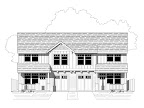Tuesday, January 5, 2016
Efficiency by Design - Design
The mere design of your house can have a big factor on your lumber bill. Think about the jogs and other dimensions in light of the dimensions of your materials. Are you attempting an 18" jog? Or worse 26"? Why is your floor 24'-6" wide?
If you're going to use materials, get the most bang out of each of them. What's the highest use of a wall stud? Precisely 24" of wall. That happens to work well for sheathing, trusses, joists and other members as well.
Yet in an effort to maximize footprints and profits, some homes may have dimensions that are less than optimal. Many designers and builders think in 6" increments. That works for a short bit until a house is suddenly 29'-6". What happened there? With a 16" or 32" floor joist or beam spacing, there's a little more than a perfect number of bays. A better number would be 29'-4". Over a 40' house those two inches represent a loss of less than 7sf. To build to a dimension of 29'-6" dictates that you might as well be building to a depth of 30'-8". In reality you're using the same amount of materials to do either. But now your building materials could support an extra 47sf of area. This is a loss.
How do you optimize this? First, design the footprint with 24" dimensions. Or at least let the trusses be optimized and use a 24" dimension perpendicular to the trusses. Think about your jogs. That 30" bay might need 3 trusses instead of 2; if only you could make it 24" deep instead. Worst case scenario, at least think in 8" increments.
But it's so much more than just building jogs. Think about your stairs. Is the location using the natural spacing of the floor joists? Or are you adding in 3 extra joists because the powder room says so? Could you redesign the powder room, nudge the stairs, and take advantage of where the joists want to be?
What about dormers and light wells? Do they comply with the natural 24" spacing of the trusses or are you buying 2 extra trusses to allow the opening to be over the front door? Can you either widen or narrow the dormer, or perhaps shift everything a few inches one way or another? Sometimes it's easier to be lazy and just buy the extra materials.
What are your interior room dimensions? Is the drywaller needing to deal with a bonus room that's 16'-2" wide? If the wall sheets are installed vertically, there's a 2" gap to fill. Cutting 2" of drywall is a pain. More likely it will get filled with mud. If the sheets are installed horizontally then the pain is a little less. Cutting a 4'-2" piece from a 12' long sheet still leaves a 7'-10" piece that is highly useful. But don't make your closet 7'-10" wide and expect the drywaller to be able to optimize that piece. At least you aren't making the room 12'-2" in the other direction, right?
All of these subtle changes can be overwhelming. But Efficiency by Design can optimize your walls to help you know what's what and what to cut. You want to stick to building. We can handle the design. Simply begin the conversation with an email or phone call. We'll handle the rest.
Subscribe to:
Post Comments (Atom)







No comments:
Post a Comment